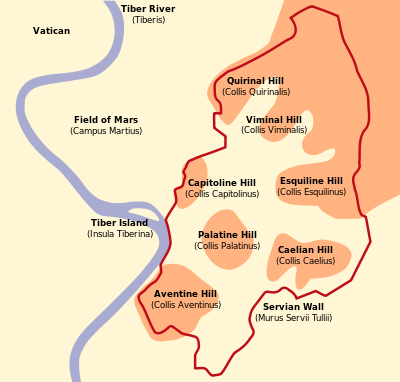Seven hills of Rome
The seven hills of Rome (Italian: Sette colli di Roma [ˈsɛtte ˈkɔlli di ˈroːma], Latin: Septem colles/montes Romae) east of the river Tiber form the geographical heart of Rome, within the walls of the city.

The seven hills are:[1]
- Aventine Hill (Latin, Aventinus; Italian, Aventino)
- Caelian Hill (Cælius, Celio)
- Capitoline Hill (Capitolinus, Campidoglio)
- Esquiline Hill (Esquilinus, Esquilino)
- Palatine Hill (Palatinus, Palatino)
- Quirinal Hill (Quirinalis, Quirinale)
- Viminal Hill (Viminalis, Viminale)
The Vatican Hill (Latin Collis Vaticanus) lying northwest of the Tiber, the Pincian Hill (Latin Mons Pincius), lying to the north, and the Janiculum Hill (Latin Ianiculum), lying to the west, are not counted among the traditional Seven Hills, being outside the boundaries of the ancient city of Rome.
History
Tradition holds that Romulus and Remus founded the original city on the Palatine Hill on April 21, 753 BCE, and that the seven hills were first occupied by small settlements that were not grouped. The seven hills' denizens began to interact, which began to bond the groups. The city of Rome, thus, came into being as these separate settlements acted as a group, draining the marshy valleys between them and turning them into markets (fora in Latin). Later, in the early 4th century BC, the Servian Walls were constructed to protect the seven hills.[2]
In modern Rome, five of the seven hills - the Aventine, Caelian, Esquiline, Quirinal, and Viminal Hills - are now the sites of monuments, buildings, and parks. The Capitoline Hill is the location of Rome's city hall, and the Palatine Hill is part of the main archaeological area.
A smaller area was covered by the seven peaks associated with the Septimontium festival: Oppius, Palatium, Velia, Fagutal, Cermalus, Caelius, and Cispius; essentially the Palatine and Caelian Hills and the western parts of the Esquiline Hill.
Other cities with seven hills
Constantinople, Lisbon, Providence and the Massachusetts cities of Worcester and Newton are also said to have been built on seven hills, following the example of Rome: "The general features of Newton are not without interest. Seven principal elevations mark its surface, like the seven hills of ancient Rome, with the difference that the seven hills of Newton are much more distinct than the seven hills of Rome: Nonantum Hill, Waban Hill, Chestnut Hill, Bald Pate, Oak Hill, Institution Hill and Mount Ida."[3] See also Seven hills of Istanbul.
In the New Testament
In the Book of Revelation, the Whore of Babylon sits on "seven mountains",[4] typically understood by Protestants as the seven hills of Rome.[5][6][7][8][9][10]
In modern literature
In a 2019 interview Lindsey Davis revealed her plan to set a series of books on the seven hills of Rome, now accomplished with the publication of A Capitol Death, seventh in the Flavia Albia series which began with The Ides of April, set on the Aventine Hill.[11]
George R. R. Martin, the author of the fantasy book series A Song of Ice and Fire, has said that he was inspired by the seven hills of Rome when creating the fictional three hills of King's Landing (Aegon's High Hill, Visenya's Hill and Rhaenys' Hill), which are a central location in the book series and share a certain resemblance to the seven hills as they were in the Roman Empire.
See also
- Other Roman hills
- Monte Mario
- Oppian Hill (Oppio)
- Velian Hill (Velia)
- Pincian Hill
- Monte Testaccio, an artificial hill composed primarily of broken amphorae
- Janiculum Hill (Gianicolo)
- General
- Seven hills
References
- Heiken, Grant; Funiciello, Renato; de Rita, Donatella (Oct 24, 2013). "Chapter 11: Field Trips in and Around Rome". The Seven Hills of Rome: A Geological Tour of the Eternal City. books.google.com. Princeton University Press. p. 174. ISBN 9780691130385. Retrieved 14 February 2019.
- "The Seven Hills of Rome", Italy Magazine italymagazine.com, accessed 14 February 2019
- Smith, S.F. (1880). "Chapter 1: History of Newton". History of Newton, Massachusetts, Town and City, from its Earliest Settlement to the Present Time, 1630-1880,. The American Logotype Company. p. 13.
- (the King James Version Bible—the New International Version Bible uses the words "seven hills")
- Wall, R. W. (1991). New International Biblical Commentary: Revelation (207). Peabody, MA: Hendrickson Publishers.
- Bratcher, R. G., & Hatton, H. (1993). A Handbook on the Revelation to John. UBS handbook series; Helps for translators (248). New York: United Bible Societies.
- Davis, C. A. (2000). Revelation. The College Press NIV commentary (322). Joplin, Mo.: College Press Pub.
- Mounce, R. H. (1997). "The Book of Revelation." The New International Commentary on the New Testament (315). Grand Rapids, MI: Wm. B. Eerdmans Publishing Co.
- Beckwith, Isbon T. The Apocalypse of John. New York: MacMillan, 1919; reprinted, Eugene: Wipf and Stock Publishers, 2001.
- https://www.youtube.com/watch?v=w3RnrRYHZ5w
- "Lindsey Davis interview: A Capitol Death and the Flavia Albia series". Hodder & Stoughton. 2 April 2019. Retrieved 10 April 2019.